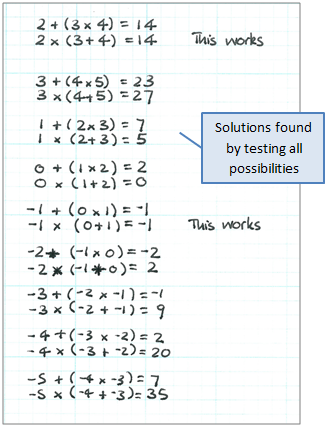The purpose of this activity is to engage students in using operations on integers to solve a problem.
This activity assumes the students have experience in the following areas:
- Apply the correct order of operations when calculating.
- Calculating with integers.
The problem is sufficiently open ended to allow the students freedom of choice in their approach. It may be scaffolded with guidance that leads to a solution, and/or the students might be given the opportunity to solve the problem independently.
The example responses at the end of the resource give an indication of the kind of response to expect from students who approach the problem in particular ways.
Task: Find three consecutive integers, a, b and c, that give the same value for:
a+(bc) and a(b+c)
The following prompts illustrate how this activity can be structured around the phases of the Mathematics Investigation Cycle.
Make sense
Introduce the problem. Allow students time to read it and discuss in pairs or small groups.
- Do I understand all the words, or should I ask for help? (Students will need to know the meaning of consecutive and integer and interpret the algebraic expressions in terms of the operations involved.)
- How should I record what I find out?
Plan approach
Discuss ideas about how to solve the problem. Emphasise that, in the planning phase, you want students to say how they would solve the problem, not to actually solve it.
- What are the maths skills I need to work this out? (Students will need to apply four operations to integers.)
- Can we work as a team to find triads that work? How will we organise our mahi?
- What part of the problem could I get started with? What is the best way to create triads of integers that work or do not work?
- Do I expect there will be a way to create triads that work? Why or why not?
- Could I make the numbers simpler? What numbers does it make sense to try first?
- Should we make a list/table? Why?
- What tools (digital or physical) could help my investigation?
Take action
Allow students time to work through their strategy and find a solution to the problem.
- Have I shown my workings in a step-by-step way?
- Have I tried all the possible cases (triads) in a systematic way?
- What is in common with the triads that work?
- Can I describe the relationships within the triads that work?
- How could I make sure that I haven’t missed anything?
- Is there another possible way to find more triads?
Convince yourself and others
Allow students time to check their answers and then either have them pair share with other groups or ask for volunteers to share their solution with the class.
- What is the solution set?
- Show and explain how you worked out your solution.
- Can others see how I worked it out?
- Do I have a generalisation that is true for all possible cases?
- How can I express my generalisation? (See Work Sample 3)
- Which ideas would convince others that my findings answer the investigation question?
Examples of work
Work sample 1
The student finds a solution set by exhaustive calculation of all the integers in the range given.
Click on the image to enlarge it. Click again to close.
Work sample 2
The student finds a solution set by exhaustive calculation of all the integers in the range given. The student shows understanding that the task is asking for the equation a+(bc)=a(b+c).
Click on the image to enlarge it. Click again to close.
Work sample 3
The student shows understanding that the task is asking for the equation a+(bc)=a(b+c) and can use this knowledge to form and solve appropriate equations to solve the problem.


